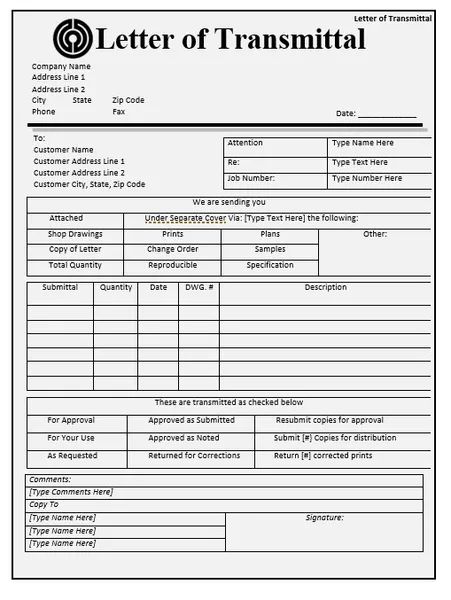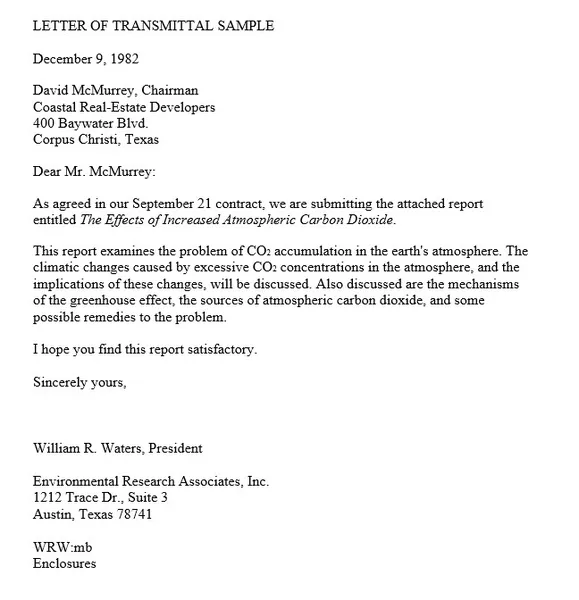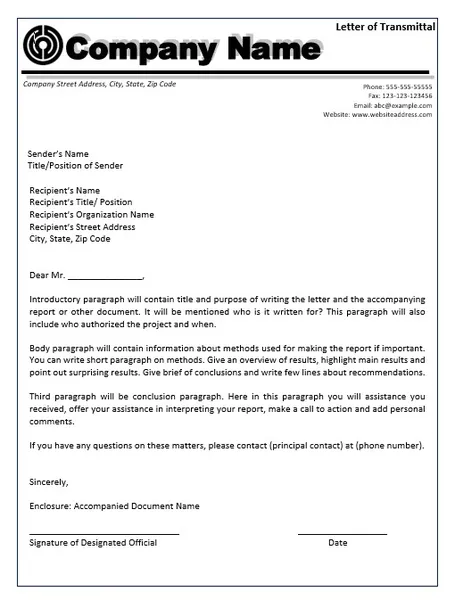Free Letter of Transmittal Template – Are you familiar with the letter of transmittal? If you do not, then you have come to the right place. The letter of transmittal is a document that comes with another large and significant document. This letter of transmittal is usually attached to explain the purpose of the letter. Simply put, the letter gives the recipient a particular context in which the document will be placed or used.
Not only that but this letter is also used to serve as documentation for the sender that something was sent and received. Usually, a letter of transmittal example is very short. The first paragraph will contain a description and the document’s purpose, which is attached.
A longer version of the letter contains the other documents’ important elements. People can also write other information for the recipient. At the end of the letter, there will be a short paragraph establishing goodwill, such as giving a compliment or a statement of gratitude to the recipient.
What is the Letter of Transmittal?
The letter of transmittal is special. It goes with big or important papers to help explain them. Think of it like a helper for the person getting the papers.







The Use of the Letter of Transmittal
The Letter of Transmittal is a guide that helps people understand important papers. Here’s what it does:
Explains Rules or Directions: Sometimes, people need to know special rules or steps for something. This letter tells them what to do.
- Example: If someone sends you a puzzle, they might send a letter telling you how to assemble it.
Goes With Contracts or Papers That Need Checking:
If someone needs to look at a contract or paper and say it’s okay, this letter goes with it. It tells what needs to be looked at.
- Example: A lawyer might send a letter with a contract to tell a client what to look for.
Highlights Important Parts of Papers:
Some papers have very important parts. This letter points those parts out.
- Example: If a teacher sends home a report card, a letter might go with it to show the best grades.
Sends Secret or Private Information:
Sometimes, information must be kept secret. This letter can go with that information to say, “Please keep this secret.”
- Example: A doctor might send another doctor a letter with private health information.
The Letter of Transmittal is very helpful. It explains things, helps people check papers, shows what’s important, and keeps secrets. It’s like a helper that ensures people know what to do with the papers they get.
What Does It Do for the Person Sending It?
- It Shows the Document Was Sent: The letter proves the document was sent. It is like a promise that the sender did what they should do.
- It Makes Things Clear: The letter helps the sender express their meaning. It makes sure the person getting it knows what’s going on.
- It Can Say Thank You: Sometimes, the letter might say thank you or something nice to the person getting it. It helps people get along well.
The letter of transmittal is very helpful. It goes with important papers and explains them. It helps both the person sending it and the person getting it. It ensures everyone understands what’s happening and is happy with how things are going. It’s like a friend helping you understand a big, difficult book!
Different Types of Transmittal Letters
Short vs. Long Versions
Transmittal letters can be like storybooks; some are short, and some are long!
- Short Versions: Short transmittal letters are like a quick hello. They tell the person getting them what the big papers are about. They don’t take a long time to read. It’s like reading a short story!
- Long Versions: Long transmittal letters give more details. They tell the person more about what’s in the big papers and why they’re important. It’s like reading a chapter book with lots of information!
Examples of What Might Be Included
- What It’s About Both short and long letters tell what the big papers are about. It’s like the title of a book.
- Why It’s Important: They also say why the big papers matter. It’s like knowing why a story is special.
- What to Do Next: Sometimes, the letters tell the person what to do with the big papers. It’s like when a story tells you what lesson to learn.
- Saying Thank You: Both letters might say something nice or thank the person getting them. It’s like saying thank you after someone reads you a story!
Transmittal letters can be short, like a hello, or long, like a chapter book. Both kinds have the same job but do it in different ways. They tell what the big papers are about and why they matter.
They help the person, getting them to know what’s happening and what to do next. They’re like helpful friends for reading big, important papers!
Parts of the Letter of Transmittal Template
The Letter of Transmittal has some parts that make it complete. Let’s learn about each part!
- The Heading: This is at the top of the letter. It has your full address, like where you live.
- The Date: This is when you write the letter. You put the month, day, and year.
- The Recipient’s Address: This is where you write where the letter is going. It’s like the address on a package.
- Salutation: This is how you say hello in the letter. You might write “Dear” and then the person’s name.
- The Body of the Letter: This is the big part. It has all the information. You tell me why you sent the letter and what the big papers are about. Also, write down your phone number so the person can call you.
- The Conclusion: This is the end of the letter. You can say “Thank you” or “Sincerely” to finish up. It’s like saying goodbye.
- Notations: Sometimes, you have to put important notes at the end. These could be things like who else will get the letter.
These parts help the letter do its job. They ensure the person who gets the letter knows what it’s about and what to do next. It’s like a puzzle, and each part is a piece that helps the puzzle make sense.
If you write a Letter of Transmittal, you use all these parts to make it perfect. Then the person who gets it can read it and understand everything!
Free Letter of Transmittal Template









How the Letter of Transmittal is Used in Different Jobs
A transmittal letter helps people understand what’s in a big envelope or package. It tells them why they got it and what they should do with it. Let’s see how different jobs use this letter:
For Business Deals and Agreements:
- Sharing Ideas: When a business wants to work with someone, they send ideas in a letter.
- Going Over a Deal: The letter helps people understand a contract before they agree to it.
In Courtrooms and Legal Stuff:
- Sending Important Papers: This letter helps people know what’s in legal papers.
For Big Projects and Studies:
- Handing in a Project: The letter tells what the project is about.
- Sharing Research: If someone learns something new, they use this letter to share it.
Talking Inside a Company:
- New Rules: The letter helps workers understand new rules.
- Welcoming New Workers: This letter helps new workers know what to do first.
For Building and Making Things:
- Sending Building Plans: This letter explains the plans if someone is building something.
- Proving Something is Safe: The letter shows that something meets all the rules.
For Doctors and Health Care:
- Patient Records: Doctors use this letter to send private health details to other doctors.
In Schools and Colleges:
- Handing Out Study Stuff: Teachers use this letter to help students understand what they need to study.
Helping People and Non-Profit Groups:
- Asking for Money: This letter explains why they need help.
- Talking to People Who Give Money: It helps thank people who give money and shows how it’s used.
Government Offices and Public Places:
- Official Things: The letter helps people understand official things from the government.
Banks and Money Places:
- Money Reports: The letter helps people understand their money reports from the bank.
The Letter of Transmittal is like a helper. It is used in many jobs to ensure people understand important papers. It tells them why they got the papers and what to do with them. It’s a very helpful letter!
Common Mistakes to Avoid
Here are some common mistakes to avoid when writing a transmittal letter:
- Forgetting Essential Parts: Missing the date, address, or salutation can make your letter look unprofessional. Always double-check to include all necessary parts.
- Spelling and Grammar Errors: Mistakes in spelling and grammar can confuse the reader or make your letter look careless. Use a spell-check tool and read your letter a few times to catch errors.
- Being Rude or Informal: Even if you know the recipient well, maintain a polite and formal tone. Being too casual or using slang can create a wrong impression.
- Writing Too Much or Too Little: A transmittal letter should be concise but complete. Refrain from rambling on, but ensure you include all necessary information.
- Incorrect Formatting: Follow a standard letter format. Incorrect alignment, fonts, or margins can make your letter look messy.
- Not Explaining the Attached Document Clearly: Remember, the letter’s main purpose is to introduce another document. Make sure you clearly explain what it is and why it’s important.
- Not Using a Proper Closing Statement: End your letter with an appropriate sign-off like “Sincerely” followed by your name. An incorrect or missing closing can seem abrupt or impolite.
- Failure to Provide Contact Information: If the recipient has questions, they should know how to reach you. Always include a phone number or email address for further correspondence.
- Not Keeping a Copy: Keep a copy of the letter for your records. If anything gets lost or there are questions later, you’ll have your copy to refer to.
- Sending to the Wrong Recipient: Double-check the recipient’s address and name spelling. Sending to the right person can lead to clarity and delays.
- Lack of Clarity in Purpose: Be very clear about the purpose of the document you’re sending. Any ambiguity may lead to misunderstandings.
- Not Following Company Guidelines: If your organization has specific guidelines for writing transmittal letters, failing to follow them may lead to inconsistencies and non-compliance.
- Not Reviewing the Enclosed Document: Before sending, ensure the enclosed document is correct and aligns with what you’ve described in the letter.
Always take the time to review your letter thoroughly before sending it to ensure it meets the expected standards.
Language and Tone Considerations
A transmittal letter’s effectiveness hinges on the appropriate use of language and tone. Below are the specific considerations to bear in mind:
Professional Tone:
- Maintain a formal and professional tone throughout the letter.
- Ensure that the language reflects the serious and respectful nature of business communication.
Clarity:
- Employ clear and straightforward language that is accessible to all readers.
- Avoid industry-specific jargon or overly complex terminology unless necessary for the subject matter.
Politeness:
- Always extend courtesy in professional writing.
- Use polite phrases and expressions to convey respect and appreciation.
Conciseness:
- Communicate the essential information without unnecessary elaboration.
- Employ direct and unambiguous language to convey the intended message.
Active Voice:
- Utilize the active voice to create clear and engaging sentences.
- For instance, “I am sending the document” is preferable to “The document is being sent.”
Avoidance of Informal Language:
- Ensure the document maintains its formality, even if the recipient is personally known.
- Refrain from using colloquialisms, abbreviations, or slang.
Consistent Tense:
- Maintain consistency in the tense used throughout the letter.
Personal Yet Formal:
- While maintaining formality, include expressions of gratitude or complimentary closings to add a touch of personal warmth.
Cultural Sensitivity:
- Be mindful of cultural norms and expressions, especially when writing to individuals from different cultural backgrounds.
- Research or awareness of cultural considerations can prevent misunderstandings.
Gender-Neutral Language:
- Use inclusive language that does not favor a specific gender.
Alignment with Organizational Tone:
- Ensure that the tone aligns with the common practices within your organization.
- Consistency in tone reflects positively on the brand and identity.
Proper Addressing of the Recipient:
- Utilize the recipient’s title if known or general terms like “Sir/Madam” if not.
- Even if a familiar relationship exists, maintain a formal tone.
Avoid Emotional Language:
- Focus on factual information and the purpose of the letter, not personal feelings or opinions.
Revision and Peer Review:
- Consider soliciting a review from a colleague to catch inconsistencies or awkward phrasing.
Attention to language and tone is integral to the effectiveness of a transmittal letter.

The content creator team at calipsotree.com is dedicated to making topics accessible to everyone, with over 9 years of experience in writing and breaking down complex concepts into easy-to-understand articles that answer readers’ financial questions.








